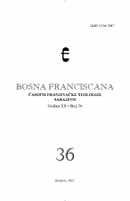Stećak sljemenjak iz Donje Zgošće kod Kaknja – novo ikonografsko tumačenje
The gabled stećak tombstone from Donja Zgoš ća near Kakanj – a new iconographic interpretation
Author(s): Ema MazrakSubject(s): History
Published by: Franjevačka teologija Sarajevo
Summary/Abstract: For more than a century, scholars have argued over the dating, affiliation and artistic treatment of the gabled stećak tombstone from Donja Zgoš ća near Kakanj. Though there are many different interpretations, no detailed, multi-faceted study of the stećak has ever been conducted, let alone an iconographic analysis. This paper therefore considers the various interpretations so far proposed of the tombstone’s visual art repertoire, followed by our observations concerning its iconographic and visual features. The highly specific iconography found here is in fact unique in the entire repertoire of extant stećaks. The textual background for this religious content is to be found in the Book of Revelations, and the paper therefore discusses in detail the relationship between the stećak and a number of late mediaeval Bosnian manuscripts (the Hval Codex, the Venice Miscellany, the Radosav Miscellany, the Nikoljsko Gospel and the Giljferding Apostolary) in which direct links have been found not only in the texts but also in the illustrations. A detailed study leads to the conclusion that the tombstone was dedicated to two members of the high nobility, probably blood relations, possibly brothers, one of whom was of higher social rank. In regard to a more accurate date for this tombstone, we shall refer only to one part of our research, concerning the inscription on the pillar from the same site. We were able to decipher the name Batalo on the copy of the pillar in the Zagreb Sculpture Gallery, not Bakulo, as read by Truhelka, which could be further evidence for dating the tombstone, Batalo being a historical figure documented in several royal charters, who lived in the late 14th century. Studying certain features of the tombstone, we observed that all the rosettes are based on a hexafoil. Some of Stjepan II Kotromanić’s coins bear a shield with a six-lobed rosette, and a six-petalled flower also features above the helmet and torse. A hexafoil is also to be seen on one of the archaeological finds from St Nicholas’ Church in Mile near Visoko on a signet ring, and on some of the seals of Kings Tvrtko I and II. These analogies may lead us towards the more specific hypothesis that this tombstone could indeed have belonged to a member of the Kotromanić dynasty, or at least someone very close to it. The fleurde- lys motif by the hunter, which is undoubtedly heraldic, also features on the coins of Tvrtko II Kotromanić, the brocade fabric found in St Nicholas’ Church in Mile, and a chapter header of the Nikoljsko Gospel. Judging from the helmets, weapons, clothing and overall workmanship of the stećak, it dates from the latter half of the 14th or early 15th century. Given the specific nature of the visual and iconographic treatment of the tombstone, we believe that the underlying idea came from within the Bosnian Church, in which the Apocalypse or Book of Revelations was a particular favourite.
Journal: Bosna Franciscana
- Issue Year: 2012
- Issue No: 36
- Page Range: 99-132
- Page Count: 34
- Language: Bosnian
- Content File-PDF

